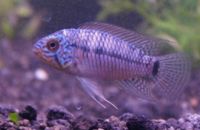Borelli's Dwarf Cichlid (Apistogramma borellii)
From The Aquarium Wiki
Borelli's Dwarf Cichlid
Apistogramma borellii
76 Litres (20 US G.)
5.1-7.9cm (2-3.1 ")
Freshwater
7.5 - 8.0
25 -27 °C (77-80.6°F)
8-18 °d
1:1 M:F
3-5 years
Family
Cichlidae
Contents
Additional names
- Banded Dwarf Cichlid, Borelli's Dwarf Cichlid, Yellow Dwarf Cichlid, Umbrella Cichlid
Additional scientific names
- Apistogramma aequipinnis, Apistogramma borelli, Apistogramma reitzigi, Heterogramma borellii, Heterogramma ritense, Heterogramma rondoni
Origin
- Leaf litter of the Mato Groso and Rio Paraguay.
Sexing
- Males have more vibrant colouration to females.
Breeding
- Requires soft water to breed. Like most Apistos, borellii are harem breeders; one male spreads his time between multiple females. This fish is a cave breeder; the female may lay from 50-100 eggs on the roof of a cave, which the male then fertilizes. Female will guard eggs and subsequent fry, while male will defend entire territory.
Tank compatibility
- Considered to be peaceful and a good community fish. Males are territorial, and if more then one male is kept in the same tank, much space and cover must be provided to allow for the creation of each male's territory.
Diet
- Good quality flake food, but should be supplemented with vegetables, frozen, freeze dried and/or live food. Mosquito larva, tubifex worms, blood worms, water fleas, brine shrimp and Cyclops are all excellent additions to their diet.
Feeding regime
- Feed once or twice a day, no more than can be consumed in a few minutes.
Environment specifics
- Provide with hiding places/caves made from driftwood and unglazed ceramic pots. In order to give them the best quality of life and enjoy the fullest display of natural behaviour, a well-planted tank should be provided.
Behaviour
- Typical cichlid when breeding. Males can be territorial.
Identification
- The body is typical in shape of other South American Dwarf Cichlids. The colouration across the body and into the fins is yellow, of varying shades, with a black band running vertically down the head and through the eye. The first few spines of the dorsal and pelvic fins also have black markings. There is also a blue colour morph and a blue with yellow head colour morph.
Pictures
Videos
External links
- Fishbase (Mirrors:
 )
)



